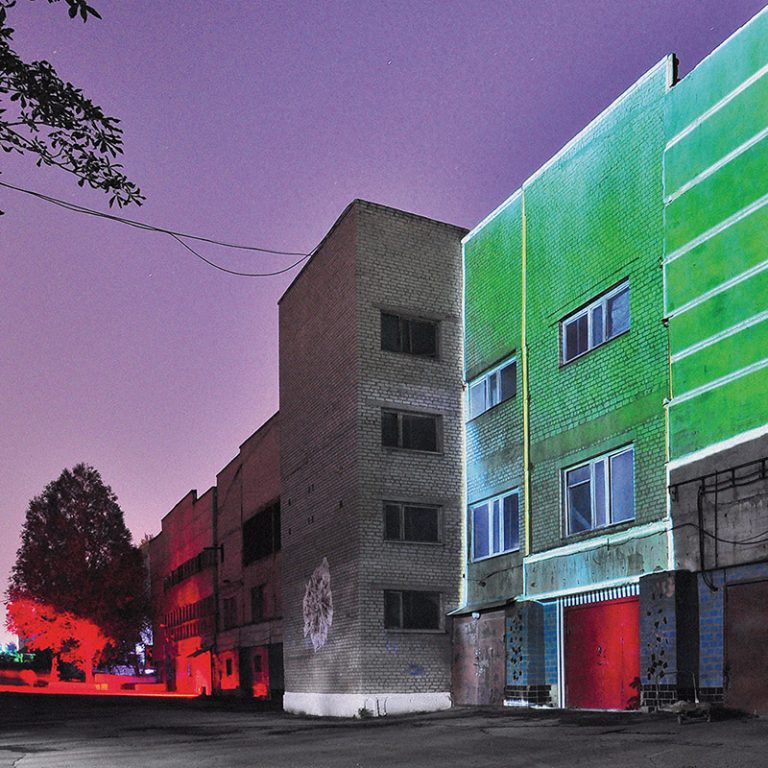Ten years ago an abandoned plant for processing insulation materials was turned into a giant art space ‘Izolyatsia’ in industrial Donetsk, but recently became a prison and a torture chamber by Russian militants. The creators of ‘Izolyatsia’ were forced to go to Kyiv and revitalize another industrial facility, which is now firmly established on the map of Kyiv as IZONE. How does this cultural centre work and do its founders plan to return to Donetsk after the deoccupation?
International charitable foundation ‘Izolyatsia. Platform for Cultural Initiatives’ was established in 2010 in Donetsk in order to develop the cultural and creative industry in Ukraine. For ten years now, cultural managers and artists have been supporting the operation of a platform for various cultural projects in Kyiv in particular and in Ukraine in general.
The space where the ‘Izolyatsia’ Foundation started its work ten years ago is now a torture chamber and a prison of the terrorists from the territories of Eastern Ukraine temporarily occupied by the Russian Federation. The team moved to the capital and settled in an industrial area, just like one from where it was forced to escape due to the Russian-Ukrainian war.
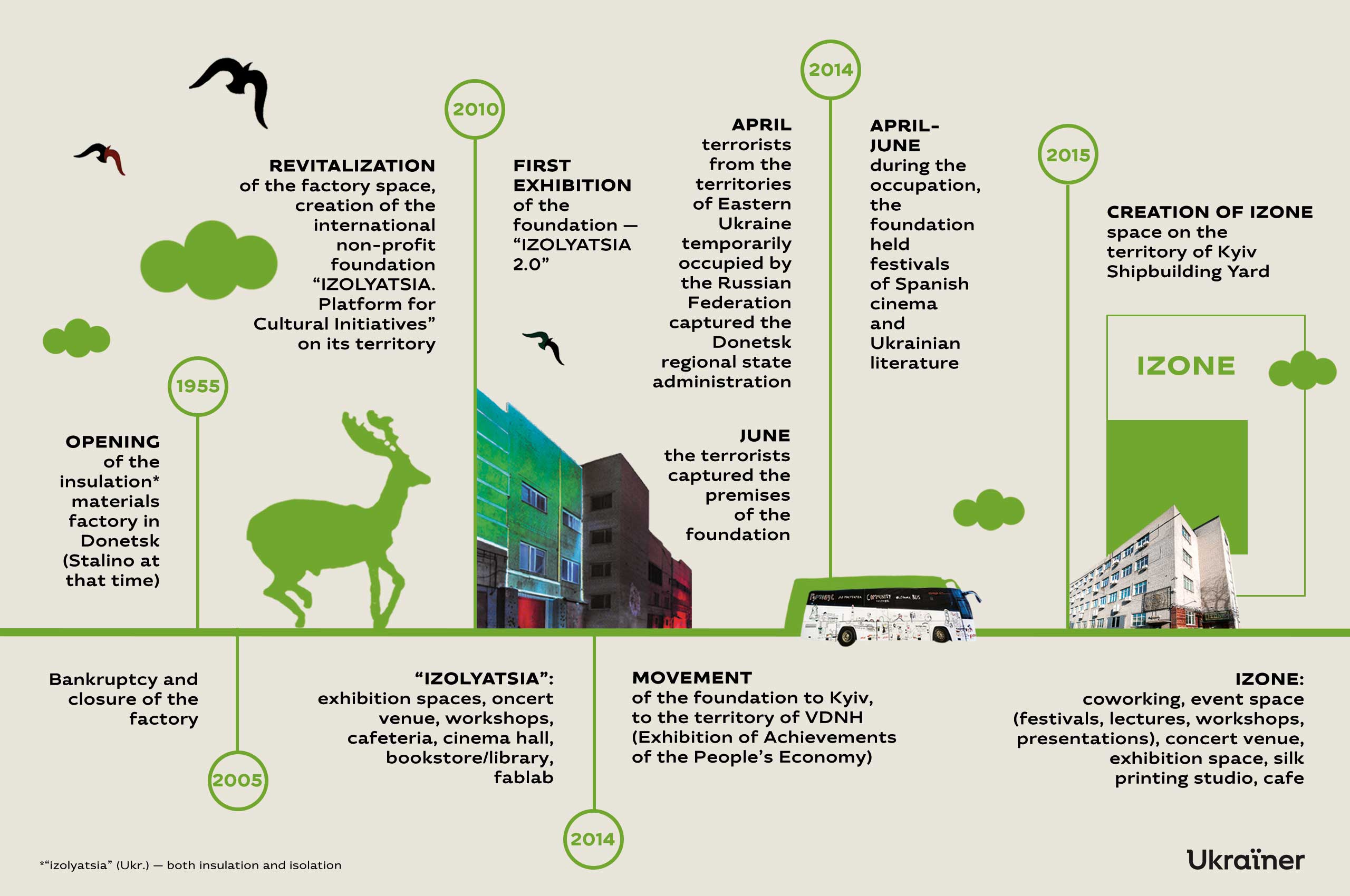
‘Izolyatsia’ Foundation. Donetsk
In the spring of 1955 a plant for the production of raw mineral cotton was built in the outskirts of Donetsk (at that time – Stalino). Before the crisis that began after the collapse of the USSR, this plant produced materials for military industrial complexes and the aviation, heating, shipbuilding and space industries. Then the plant was left without orders, infrastructure support and state funding from the new, formerly Soviet republics. It went bankrupt and closed in 2005.
The ‘Izolyatsia’ Foundation was established in 2010. The daughter of the last Soviet director of the plant, Lyubov Mikhailova, invested in a project that, according to her plan, was meant to change the cultural and educational landscape of Donetsk and Ukraine in general.
While in European countries it has long been common to set up cultural initiatives in abandoned industrial areas, such as former factories or mines; in Ukraine no one thought about it. Lyubov appealed to the city council with a proposal to renovate the space of the former plant, but her initiative was not supported. Then Lyubov privatized the plant, independently invested in the ‘Izolyatsia’ Foundation and invited other entrepreneurs to join her.
‘Izolyatsia’ did not attract funds from organizations associated with the so-called Donetsk mafia or oligarchic world as a matter of principle. Instead, they worked with companies that cooperated with the EU, Britain and the United States, and with organizations whose values coincided with theirs.
Thus, culture, creativity and art began to blossom on the territory of the former insulation materials plant. Hence stands the name of the fund — ‘Izolyatsia’ (‘Izolyatsia’ Ukr. — both insulation and isolation).

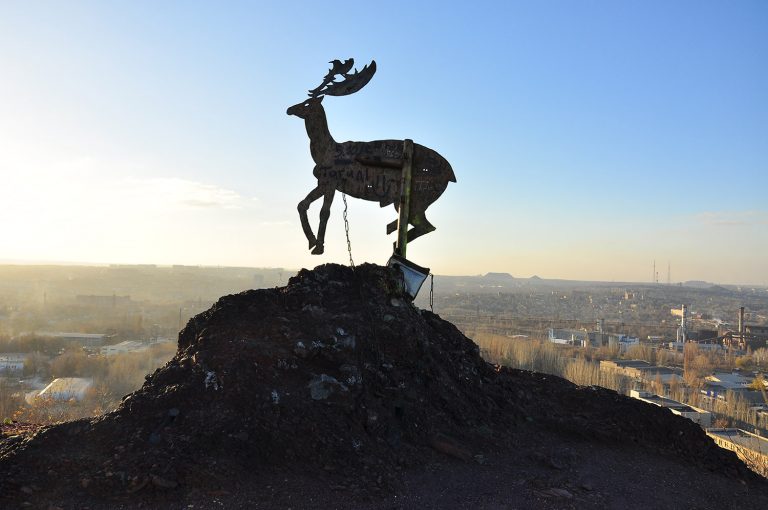
slideshow
The first exhibition of the new centre had to take the name ‘IZOLYATSIA 2.0’. Like a reboot. Under the supervision of Adam Nankervis, five Ukrainian artists (David Chichkan, Yuri Pikul, APL315, Gamlet and Volodymyr Kuznetsov) worked with themes of transformation and interaction between nature and the urban in mind.
Mykhailo Glubokyi, development director of the ‘Izolyatsia’ Foundation, says it was the first such art project in Donetsk.
— At that time in Donetsk, except for the State Art Museum and the Donetsk State Folk Museum, Drama Theater and Opera House, there was no other culture. And this was just on an official level. Of course, there was no independent or alternative culture at all.
There was no competition in eastern Ukraine and no alternative venue for such events, so the foundation’s team decided to expand across the entire plant to have more opportunities for exhibitions and film screenings. The demand for cultural events and installations in ‘Izolyatsia’ was insane.

Photo from the archive of the ‘Izolyatsia’ Foundation.
For example, the community of Donetsk artists undertook a project led by Chinese artist Cai Guo-Qiang, called “1270 meters underground”. Today, Cai Guo-Qiang is a well-known artist working in New York. ‘Izolyatsia’ offered him to explore the theme of mining in a joint project. This turned out to be close to the artist, who was born and raised in China. In Donetsk, Cai Guo-Qiang created huge portraits of miners painted by fire: the artist spread gunpowder on the contours of the portraits and set them on fire.
The project resulted in two exhibitions: portraits of miners and a mobile installation of mining carts, representing miners’ life.
Mykhailo is convinced that if ‘Izolyatsia’ had urged the artists to bring ready-made exhibitions, the audience would not have been able to experience the art as they did.
— People came and brought their relatives. The children were accompanied by the miners whose portraits had been painted, as they wanted to look at themselves… there were many people. The institution immediately became a place where everyone understood that here the art is about us, about our problems, about everything that’s going on around us.
This approach then became foundational for ‘Izolyatsia’.

Photo from the archive of the ‘Izolyatsia’ Foundation.
Seizure
On April 7, 2014, terrorists from the territories of Eastern Ukraine temporarily occupied by the Russian Federation captured the Donetsk regional state administration. Armed separatists appeared in the city and began to introduce and implement their rules, all at the same time. The ‘Izolyatsia’ Foundation continued to work on a full-time basis, as it was understood here that culture and art were especially needed in times of complete instability and fragility. It was exactly then that the festival ‘10 years of Spanish cinema’ took place.
— We screened the movies. People came, especially elderly women, who had not been here before. In the end, they came up and thanked me, saying: “There, in the city, something is going on! People with weapons, we don’t understand it. But we can come to you, where it’s calm, safe and we can watch a good movie.” So we tried hard to continue our activities to support local people so they could come and have a place to avoid the distress that had already gripped the city centre.
Adherents of the separation idea then said that “the world needs to hear the voice of Donbas” and separate from Ukraine. The ‘Izolyatsia’ team instead decided to showcase a different voice and held a major festival of Ukrainian literature. Throughout the week, Ukrainian writers, poets, and artists came to Donetsk to declare aloud their position on culture and statehood.
The abandoned insulation materials plant became an open platform for discussions, and not only about culture and art. The dialogue between the festival participants, who came from different parts of Ukraine, seemed to reproduce in miniature what was happening across the country during the first six months of the Russian-Ukrainian war.
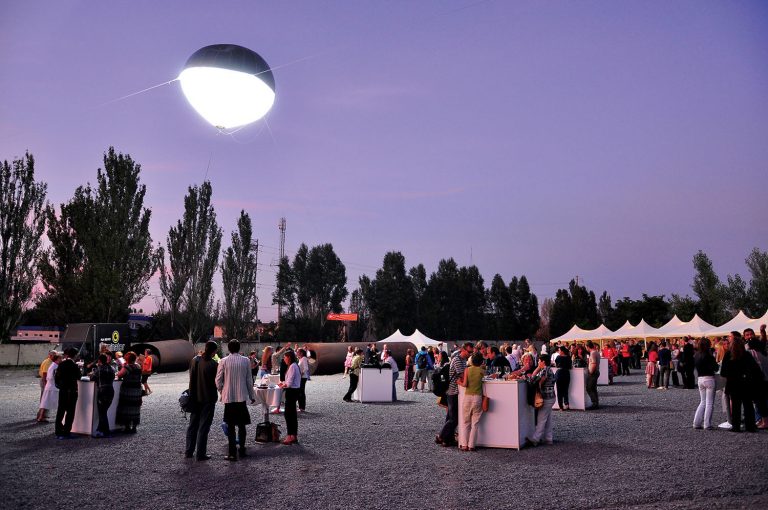
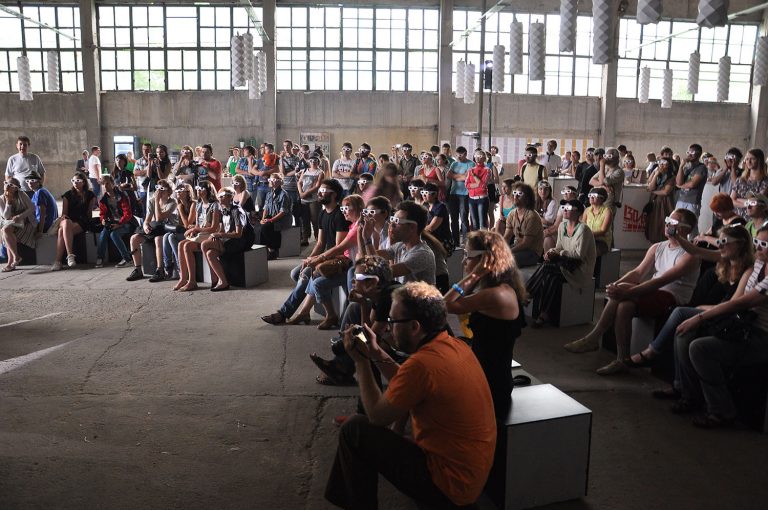
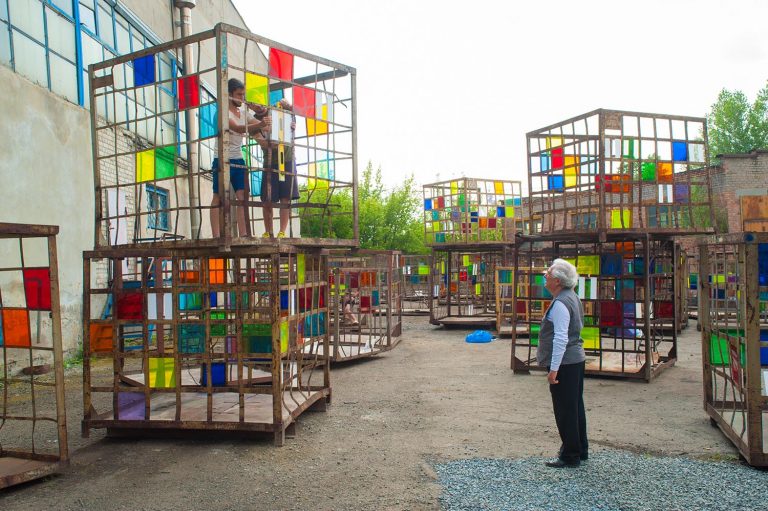
slideshow
The artists needed space for their reflections on the hostilities on the Donbas territory, and the audience was happy to look at the exhibitions, where they could take part in a thorough dialogue. Team member Maryna Samokhina says:
— I know for sure that before the war, ‘Izolyatsia’ in Donetsk was an unusual phenomenon, not typical for Donetsk… an atypical organization where relationships were established on particular principles, with some broader ideas about self-fulfillment for each person. And in Donetsk, ‘Izolyatsia’ offered an alternative perspective for ordinary people which resonated with them.
On June 9, 2014, armed men came to the ‘Izolyatsia’ site and claimed that from now on the plant belongs to them and will be used to store humanitarian aid from Russia. Most of the team was outside Donetsk at the time, and they have not returned home since learning that the terrorists had taken over the area.
Since then, all of the foundation’s facilities have been converted into prisons and torture chambers, as well as ammunition depots. The building, which was the main office and exhibition space of ‘Izolyatsia’, is now used as a militant barracks and a place to store weapons. Mykhailo Glubokyi shows:
— There is also a large underground bunker under this building. Because in the Soviet Union all plants were built in such a way that they could work even during a nuclear war. These basements are also used, sadly, as premises where people are now kept illegally.

Moving
A new stage has begun for the ‘Izolyatsia’ Foundation. Unable to return home due to the Russian-Ukrainian war and the occupied space of the plant, the team remained in Kyiv and realized that it was necessary to continue persevering in the work begun in Donetsk — to develop the culture of Ukraine. After all, it is culture that helps people to stay afloat in difficult times.
Kyiv-based organizations, including the ‘Chasopys’ coworking space and the ‘Closer’ art club, offered their spaces for projects embodied by ‘Izolyatsia’, and its first office in the capital was at the Kyiv VDNH (Exhibition of Achievements of the People’s Economy). The team continued to work primarily with the Donetsk audience, who moved to Kyiv after the war started.
Most of the ‘Izolyatsia’ projects were devoted to what was happening in Donetsk and Luhansk during the occupation. No one knew, and sometimes still do not know, how life had changed there after the start of the Russian-Ukrainian war: what is the new rule of law, what restrictions are in place, or how they are encouraged to live. The voice of ‘Izolyatsia’ projects began to be heard through the lens of the stories of team members and their families. Mykhailo recalls:
— Many people ask us how did we react, how was it possible to work in such a situation. In fact, we started doing a lot right away, and it probably helped most of us to stay sane and calm. It was necessary to work, so there was no time to reflect on what was happening.

Mykhailo Glubokyi, development director of the ‘Izolyatsia’ Foundation
In the winter of 2014, ‘Izolyatsia’ participated in the ALERTE program of the French Art Museum Palais de Tokyo in Paris, which conducts a dialogue with artists and institutions whose countries are at war. Instead of talking about the situation in Ukraine, the team decided to show the audience the interviews with those who seized the insulation materials plant and those who were there in captivity. Even the international Red Cross does not have access to the prisoners, however the Russian TV channel ‘Dozhd’ was able to obtain it.
In 2015, at the Venice Biennale, the ‘Izolyatsia’ team ran a social media campaign #Onvacation. Visitors could wear a military uniform with the inscription #Onvacation on the back and go to the pavilion of the country they consider to be the aggressor country. With the help of such an interactive action the narrative on the story of the Russian-Ukrainian war continued to be told in the West. In particular, how the Russian military occupying Donetsk and Luhansk stated that they had come to Ukraine not on the orders of the Russian military, but at their own will — “on vacation”.
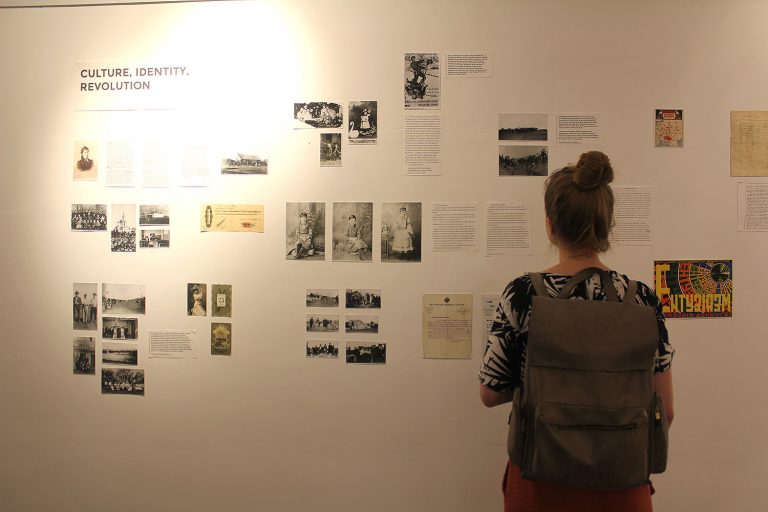
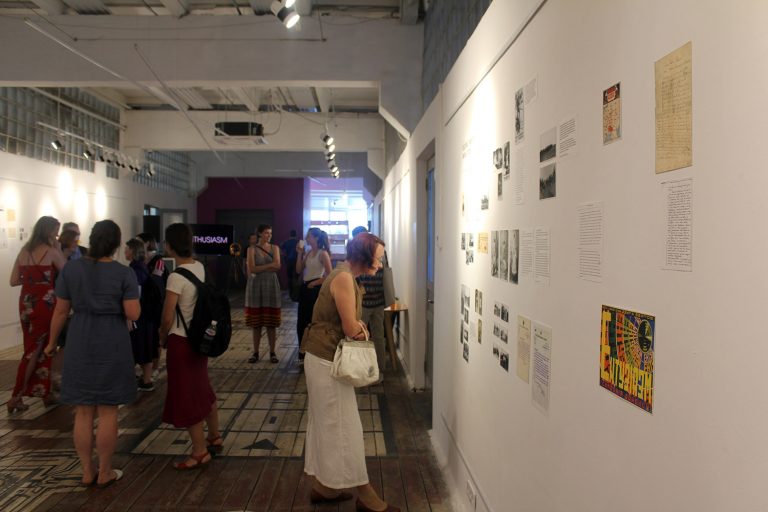
slideshow
The exhibition ‘From Wales to Ukraine. History of Yuzivka’ in 2019 was a project of Victoria Donovan and Stefan Keddika, dedicated to the British mining engineer John Hughes, the founder of Donetsk (previously known as Yuzivka. — ed.), and a group of migrants who came to Donbas, tempted by the invitation of the Russian Empire to invest in industrial development.
The social and cultural institutions founded by the British changed the lives of the locals. In particular, tearooms, tennis courts and the Anglican Church have been Donetsk trademarks for some time.
Through personal stories, letters, memoirs and photographs, the curators of the exhibition wanted to explore how migrants experience relocation: what they dream about and what they fear; what benefits migration brings; what potential migrants can create (for example, entire cities), and how isolated industrial areas can be. Yet this complex history of industrialization in the region was told through simple and understandable language of everyday life. Mykhailo also mentions how Ukrainian and British cultures influenced each other:
— There are photos taken in Donbass of John Hughes’ children in embroidered shirts or the schools they went to, the institutions they founded: churches, clubs. It is known that the first street in Luhansk was called “English”.
Mykhailo is convinced that it is important to use historical and cultural heritage for development. To know local history, remember who did what and how cities were built, is to understand your past.

IZONE. Kyiv
Upon arrival in Kyiv, ‘Izolyatsia’ settled in the VDNH, but the terms of the agreement did not allow the team to work at full capacity. British architect Rick Rowbotham, who helped the team with the spaces, suggested they look at the Kyiv Shipbuilding and Ship Repair Plant complex, located near the city centre in Kyiv’s industrial district. The ‘Izolyatsia’ team heeded and was the first group to rent the space (today there is a huge queue for the rent!).
Then, in addition to the foundation, ‘Izolyatsia’ founded a creative community called IZONE. ‘Izolyatsia’ is primarily for cultural, artistic and social projects, while IZONE conducts commercial activities. All the profits from this social enterprise go towards paying the rent for and installing ‘Izolyatsia’ projects.

Coworking
Initially, the ground floor of IZONE was used for large events such as film festivals, film screenings, concerts, conferences and exhibitions. Videos of various projects were being shown on big screens. However later the team realized that they did not have enough resources to support the work of the two exhibition spaces, and so one hall was allocated for coworking.
This decision was also prompted by a request for a joint work area from people from the creative community. Those who make films, animation, advertising, photography, work in the field of architecture, urban planning, etc., can now create under one roof. This is how a creative community is formed, by occupying the same space.
Rick Rowbotham developed the concept of working space in the hall which served as a laboratory at the plant: original beams, cranes, elevators etc have all been retained. The architect deliberately left metal in the hall to reflect the industrial spirit of the plant. It is important to preserve the industrial heritage, Mykhailo Glubokyi is convinced:
— It was important for us to keep the spirit of the plant so that all this would not turn into an ordinary business centre or office space — there are many of those. That’s why we use steel structures here, which look as if they were in the plant before. This is a special iron that oxidizes very quickly, so it rusted very quickly. It’s as if it has been sitting underwater for a very long time.

The coworking space is divided into two parts. Open Desk is accessible to anyone: you can work here during business hours. There are also separate studios for those working in the creative industries — here the ‘Izolyatsia’ team assesses whether the values of the projects coincide before allocating these more permanent spaces to specific artists. Among IZONE residents are artists, architects, film and video production, fashion designers, programmers, designers, sculptors and many more.
The demand for coworking is growing every year, as the culture of cooperation of different teams in one space develops. Now IZONE coworking covers two floors, where at least 30 teams work on a variety of creative projects.

Silk-screen printing studio. Marina
IZONE has a coworking workshop with a silk-screen printing studio. Artists and entrepreneurs cooperate: here you can work on both commercial and personal projects.
Maryna Samokhina is a designer and workshop manager, one of the first members of the team to join ‘Izolyatsia’ in Donetsk and move to Kyiv with her colleagues.
— A new context has appeared in Kyiv. We had to rethink everything we do and will do in the near future. Perhaps societal changes are causing us to search for new ways of perceiving the world. They offer me a chance to make sense of what I can do to reach out to society. In this general period of rethinking, I have found my niche in silk-screen printing.
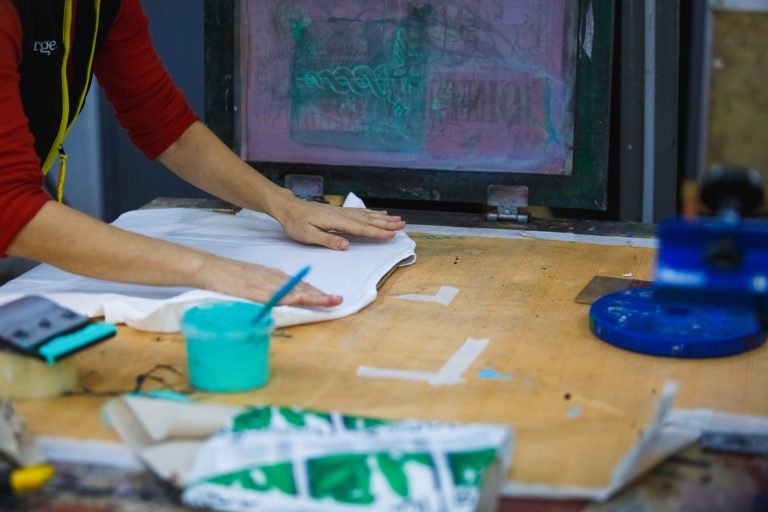
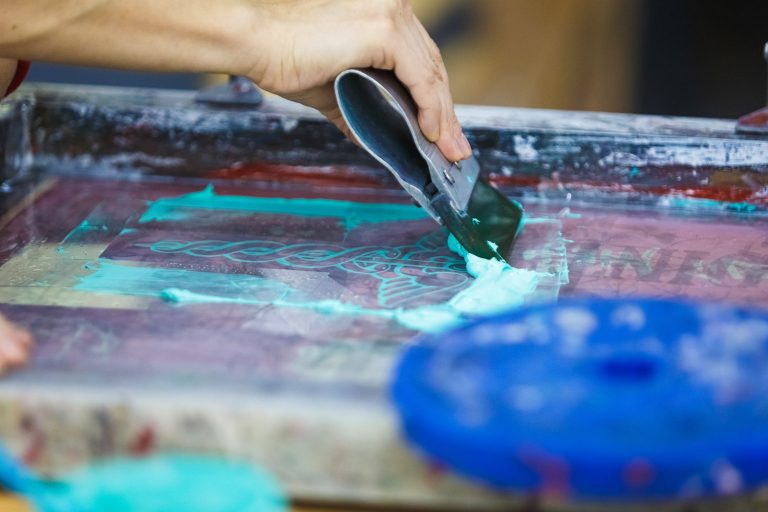
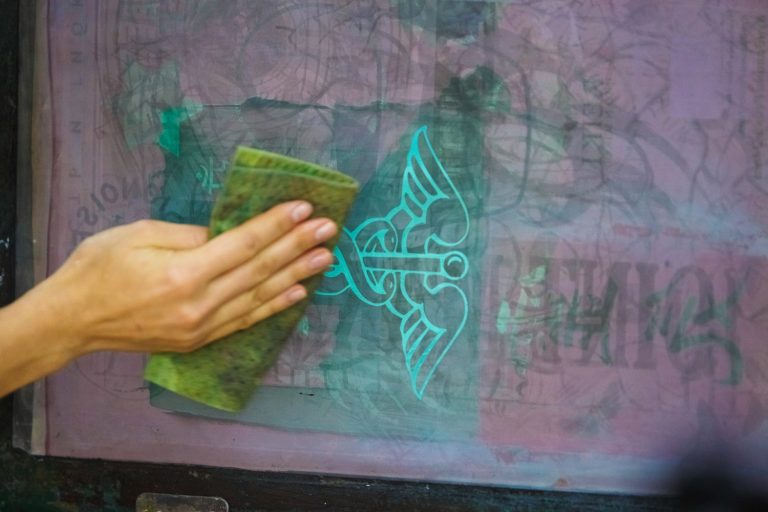
slideshow
The workshop has an engraving machine, which makes items from metal, cardboard, plastic, linoleum and more. The main direction of the workshop is silk-screen printing. The entire printing process is done manually, and the printing stations work exclusively with stencils. Using light-sensitive emulsion, light and images on transparent media (tracing paper or film), the team makes a stencil. This image is then transferred onto silk.
In addition to production, the workshop also conducts training. Some students become committed IZONE coworkers, and those who just want to try their hand at the art of silk-screen printing can take part in print parties.
— We advertise our work but only invite people to join us in small numbers , particularly interesting personalities whose works use some practices which inspire us. We can reproduce them here in the workshop. It has already become quite a cool and soulful event. Each maker has found meaning in their own work. And each can share it with others in this space.

Public and exhibition space. Kateryna
On the third floor of IZONE there is space for public events. For example, every Wednesday, artists, sculptors and other artists hold mini-exhibitions as part of the ‘Art Wednesday’ project. Sometimes, in addition to the works of famous artists, the works of young artists who do not yet have exhibition experience appear in the space.
This is a unique opportunity for them to present their artworks in a recognized space and include an exhibition in IZONE in their portfolio. The theme of the exhibition should correspond to the values of ‘Izolyatsia’: it should be a critical piece with meaning embedded in the work.
Exhibitions and installations in IZONE have existed since the foundation of the space. Every year there are several large exhibitions, not limited to any particular format. In February-March 2020, in cooperation with the “Babyn Yar” Holocaust Memorial Centre, the ‘Izolyatsia’ Foundation presented an installation by French artist Olga Kisseleva.
The installation ‘Memory Garden’ was dedicated to the tragedy in Babyn Yar. Communications manager Kateryna Igolkina says that this project is a prime example of art-science, an art direction that combines culture and science.
— It is called ‘Memory Garden’ because the artist researched together with scientists, having literally listened to the trees of Babyn Yar, which bear the memory of tragic events. Unlike humans trees are not biased, they do not bear ideological colours. The artist studied and recorded the movements inside the trunks of these trees, and then, together with scientists, turned them into a video installation.

Prior to that, ‘Izolyatsia’ organized an installation ‘Remont’ (Ukr. “Repair”), in which home renovation featured as a metaphor for the state of affairs in society. Nadia Kaabi-Linke, a Tunis-born artist of Ukrainian origin, appealed to changes, revolutions, political, economic and environmental situations in the world. The cobblestones scattered in the exhibition space created a sense of instability: they were difficult to walk on. In the same way, it is difficult to exist in an unstable world.
In addition to individual projects, IZONE hosts art residencies — this is one of the key activities of ‘Izolyatsia’. Art residencies allow artists to share experiences not only within Ukraine but also with foreign colleagues. Artists come to Kyiv, live in a dormitory on the IZONE site and work in the centre for a month.
The interaction between the ‘Izolyatsia’ team and Ukrainian artists with the guests of the art residencies is manifested in the projects they create during the month. What does this kind of cooperation mean for Ukrainian artists? Kateryna explains:
— Information exchange and the fact the artists can tell the world that in Kyiv, in Ukraine you can do cool things. Foreign artists go home and share that there is an interesting context in Ukraine that is worth knowing about globally.

Gurtobus. Clemens
One resident artist is Clemens Poole, who has been curating ‘Izolyatsia’ projects for five years. Clemens comes from New York, where he met the team in late 2013. The curator arrived in Kyiv on June 8 of the following year, the day before the terrorists seized the insulation materials plant. The idea for the first Kyiv project — ‘Zahoplenya’(‘Seizure’) — arose organically as a reflection on the events in Donetsk.
Clemens is currently in charge of the ‘Gurtobus’ (Ukr. ‘gurt’ for ‘union’ and Eng. ‘bus’) project, a 12-meter Volvo bus converted into a mobile cultural centre travelling through the regions of Ukraine. The project team organizes cultural and educational events, film screenings, meetings with famous people. And develops the potential of local communities.
— We have created a mobile cultural centre, which does not tell people what culture is, but, on the contrary, asks locals to share what they believe it to be. All of the programs engage communities of ordinary Ukrainians. We are posing questions rather than giving answers.
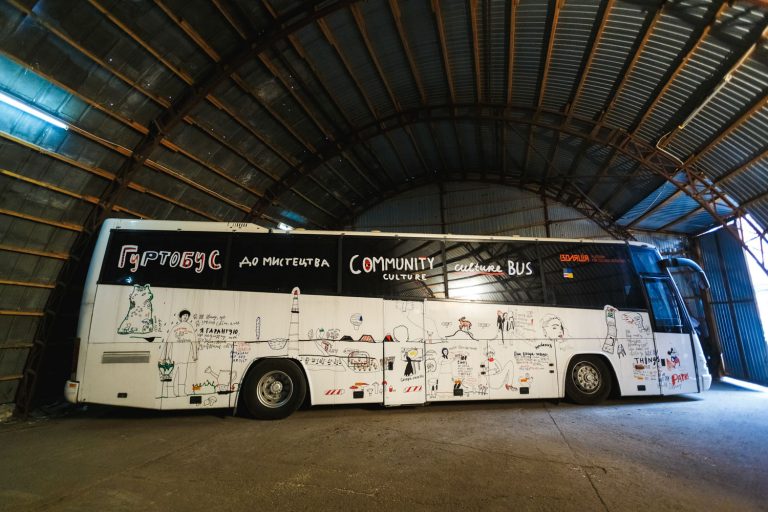
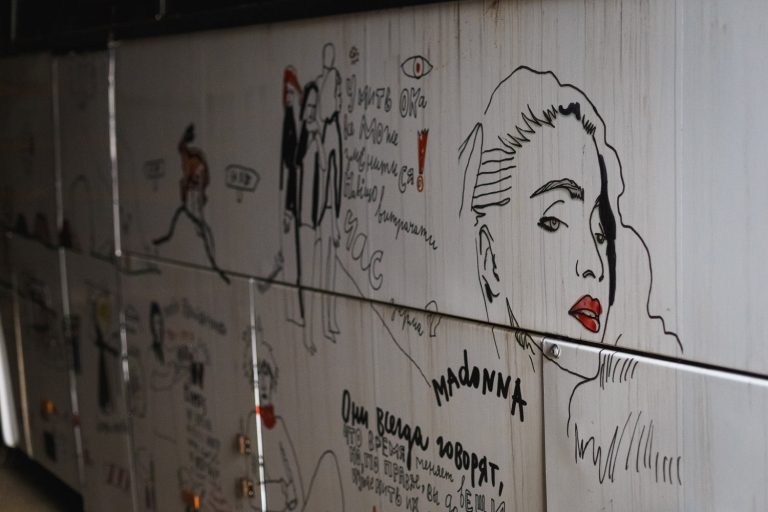
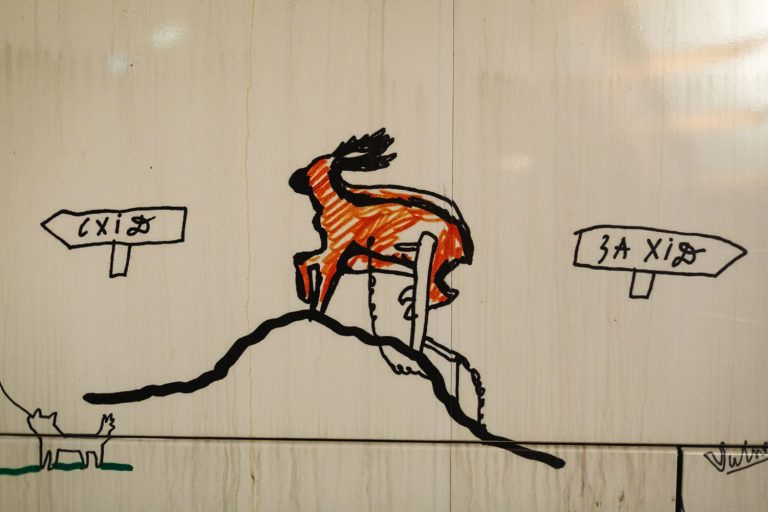
slideshow
This is an effective way to encourage people to think about cultural topics, and that is why Clemens is convinced that the project is still relevant. The decentralization of culture is built on working with residents in small towns, where heavy industry facilities are located, but cultural activities are lacking.
— But for us this does not mean that culture has been concentrated in one place and should now be decentralized. The point is that the support of culture, its funding and critical thinking are centralized. We try to decentralize the support of individuals who work with cultural topics.
As a result of large-scale art residencies in Donetsk, specific projects were created — projects designed to change the landscape of the “‘Izolyatsia’ plant over the years. Such residencies are now being held to transform other cities. Last year in Severodonetsk, the ‘Izolyatsia’ team organized a summer school dedicated to monofunctional cities. Researchers, artists and activists had the opportunity to interact and create a new cultural product to spread knowledge about this region, previously known only for its industry.

Donbas Studies. Dmytro
At the entrance to the library of ‘Donbas Studies’ there are artworks by Gamlet Zinkivskyi, which he created in Donetsk during an art residency in 2010. Portraits of plant workers painted on metal canvases are some of the few works that have been saved after terrorists seized the plant.
The ‘Donbas Studies’ project was created in 2014 in Donetsk, when there was a need to talk about changes in the geopolitical situation in eastern Ukraine and the public discourse at the time.
Dmytro Chepurnyi, the project coordinator, says that this interdisciplinary project has a public program, a research direction and a library. An important part of the public program is the summer school, an international residency that brings together researchers, artists, curators and activists from all over the world.
— Researchers deconstruct, curators and artists create something, activists organize. It is essential for us that there is a synergy between these three or four categories that can produce some interesting results.
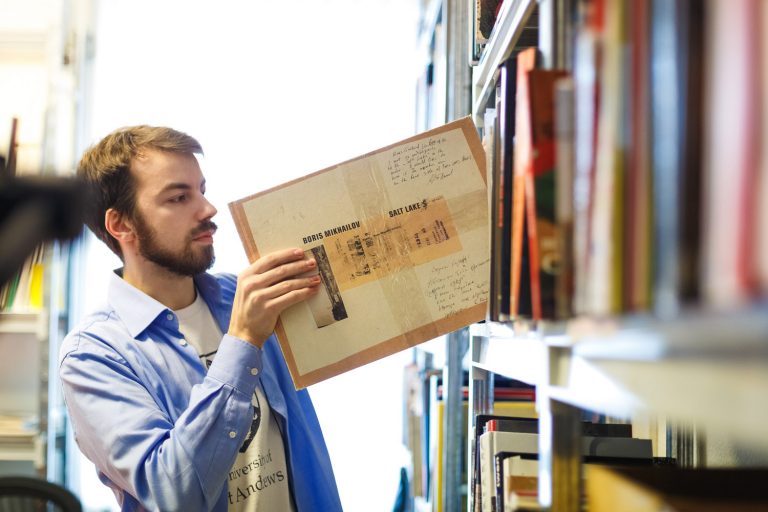
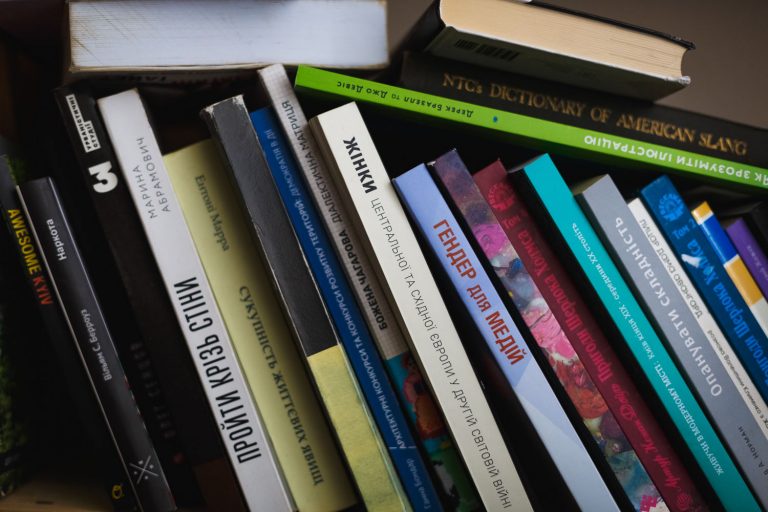
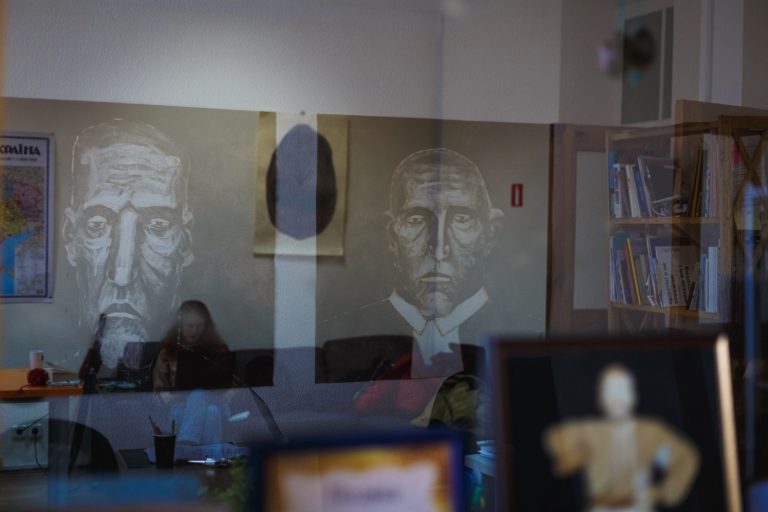
slideshow
The library was formed gradually and is still being formed to this day. The books in the library are mainly about the Donetsk and Luhansk regions: their past, present and future.
Part of the library of ‘Donbas Studies’ is the library of ‘Gurtobus’.
— The books come here very randomly: sometimes we buy them, but more often presentations are donated to us or brought here by our residents. Or sometimes when we research a topic, we buy books about a specific field of art or artist, if it is a mono-exhibition.
Dmytro joined the ‘Izolyatsia’ team thanks to his university term paper as he came to read literature on the subject. He was later invited to join the project and agreed due to the fact he was from Luhansk and was interested in the history of the region.
— When I had the opportunity to read all the books that were here in the library, I took advantage of it. As Karl Marx said, we must not only describe the world, we must also change it, that is, do something — either complete a residency, or an exhibition project directly in this space. It seems to me that some post-Soviet industrial territories and cities (Lysychansk or Severodonetsk, Sviatohirsk or Mariupol) seem to have been created for this kind of cultural intervention.

Since the forced relocation to Kyiv, ‘Izolyatsia’ has been constantly working with stories about Donbas and its people. In 2020, ‘Izolyatsia’ plans to shift the focus of its activities from Kyiv to eastern Ukraine, i.e. to open a branch in the region and cooperate with local partners. Dmytro emphasizes:
— The issue of Donbas being returned is important for ‘Izolyatsia’. How can you decentralize an institution, how can you feel at home without access to your hometown? I think it’s important to gather a kind of community, to do something, not to go mad, to somehow come to terms with what is happening to all of us.
While ‘Izolyatsia’ operates in Kyiv and opens the world of culture, creativity and art, working on important social issues, the plant currently remains in the territory of the ‘Russian world’ and functions according to its rules — isolating and imprisoning people. The freedom of pursuit, action and experimentation that the ‘Izolyatsia’ team now has in Kyiv is the complete opposite of the conditions in which the industrial space where it all began currently exists.

